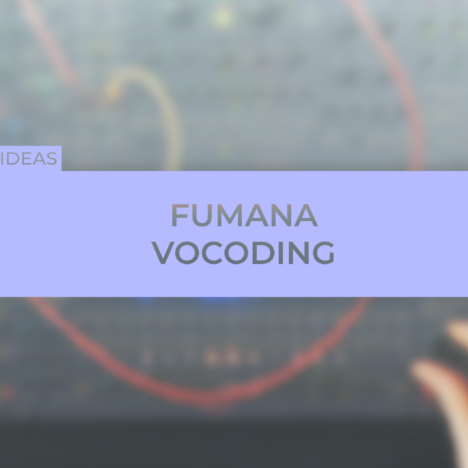- EURORACK
- CUNSA – Sound Seasoning
- CGM – Creative Mixer Series
- BRENSO – Entangled Sound Sources
- USTA – The Voltage Score
- FALISTRI – Movement Manager
- SAPÈL – Tamed Random Source
- FUMANA – Dual 16 Bands Spectral Editor
- 321 – Scale + Flip + Shift + Combine
- 333 – ProAudio Sum & Distribution
- SILTA 2016 – discontinued
- SEI – trunk lines – discontinued
- UNO – foldable case
- PLUS – modular modular case
- ACCESSORIES
- KNOBS
- 500 SERIES
- RESOURCES
- RESELLERS
- ABOUT
- ACCOUNT
Tag / FUMANA
-
FUMANA: Theory and Practice
A seminar about everything FUMANA! Spectral transferring, parametric scanning, dynamic EQ, vocoding… You name it. Come and join us to share your questions and thoughts.
2021-03-15 -
FUMANA: Theory and Practice
A seminar about everything FUMANA! Spectral transferring, parametric scanning, dynamic EQ, vocoding… You name it. Come and join us to share your questions and thoughts.
2021-02-24 -
FUMANA Vocoding
IDEA The sixteen filters of FUMANA are well laid out on the front panel. What may not be obvious at first glance, however, is that sixteen more filters are laying under the…2020-11-17 -
Quadrature Drones
Quadrature Mode is more than just ADSR: in this patch we use it to create two interconnected LFOs, which animate the stereo image of our BRENSO oscillator.
2020-11-02 -
Spectral LFO
Here’s what BRENSO’s green oscillator is capable of when used as an LFO! We patched its square out to FUMANA’s mod input: this will excite the envelope followers and “ping” the filters. We then patched its saw out to the parametric scanner CV input, and let the phase relationship do the rest!
2020-09-30 -
TZFM Spectral Transferring
BRENSO as carrier AND modulator! Here’s what’s happening: the yellow FINAL output is FUMANA’s carrier, the green Saw output is FUMANA’s modulator, BUT the yellow oscillator is also modulating the green one! So, the yellow oscillator is frequency-modulating the green one which in turn is performing spectral transferring over the Final waveform.
2020-09-30 -
Spectral Sequencing
USTA has 16 outputs, FUMANA 16 bands. Let’s take advantage of this coincidence!
2020-08-31 -
Root Shift
Time to play modal! The Root Shift is a modulation that takes any incoming CV and shifts the root of your quantization mask. The result is a dramatic change in the song mood, but if you route the same CV to the Pitch Shift modulation, you will transpose the whole scale!
2020-04-28 -
Pitch Shift
USTA features two independent CV inputs, whose signal can be internally routed to several destinations (independently per track, of course).
2020-03-31 -
Song Mode
We’ve seen how to change the pattern loop settings, and how to recall other patterns on the fly temporarily, but there’s another option that let you organize your sequences in a fixed form: the Song Mode.
2020-02-28
Categories
Recent Posts
- CUNSA v/s FUMANA: The same patch on two different filters!
- Subharmonic formant arpeggios patch breakdown: a classic Falistri patch!
- Memes aside, let’s make Sandstorm by Darude on our Frap Tools system
- Four tips to use CUNSA as a sound source (including ringing and additive synthesis)
- ‘Glass sounds‘ analog through-zero FM patch breakdown with Brenso and Cunsa!








